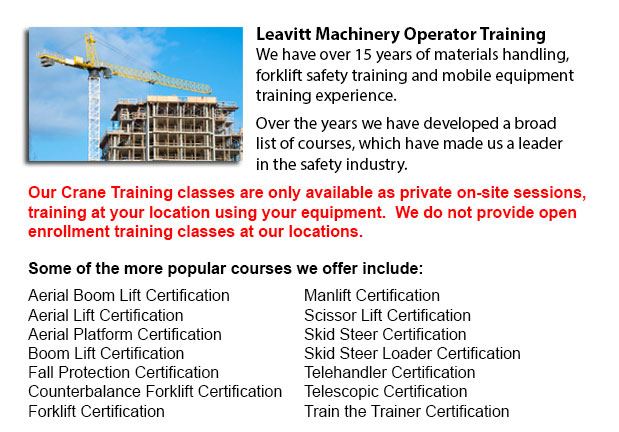
Crane Certification Glendale - The Crane Certification Program consists of the industry suggested subject matter which will teach the safe and efficient operation of cranes. The individual would train in the following: how to identify cranes and their component parts; pre-operational, operational and post-operating requirements; how to determine overall lift capacity; rigging components and inspection/rejection criteria; and needs particular to the work site where the trainees will be operating.
The requirements which must be performed before operating a crane such as assigning authority for the pre-operational check; doing the sequential pre-operational check based on the manufacturer's specifications or specifications certified by a professional engineer; checking the log book for comments; inspecting the work place for hazards and obstacles; inspecting chains, cables, hooks safety latches and crane movement; making sure of the correct functioning of operational controls; and knowing how to make certain that the disconnect switch/isolator of the crane is properly working.
Operational requirements include identifying roles and responsibilities, and determining the requirement for a formal lift plan. People training will know how to perform a danger assessment connected to environmental conditions, physical situations and workers. Subject matter comprises determining when to seek competent support, the destination of loads and the safest route, and centre of gravity and load weight.
Individuals training should be able to identify an over-capacity lift, in addition to be able to pick appropriate rigging machinery, select load restrictions, and to determine the safe spot for the crane to work from. Trainees would review both universal and site-specific crane signals for lifts, and methods for traveling, lifting and loading. Proper maintenance habits would be covered.
The person training would undergo an examination to test their understanding of emergency response procedures for various circumstances, specially mechanical or electrical failures. They would be asked to describe shut down and parking procedures for safety and security, to follow tagging and lock out procedures, and to explain why near misses are recorded and reported to the appropriate person. Log book records have to be maintained.
People training would develop knowledge of rigging, particularly, establishing who has responsibility and authority for rigging, identifying various kinds of rigging, knowing storage procedures and load capacity ratings.
Post-operational requirements include entering deficiencies or defects, service and maintenance history within the log book, based on provincial, federal and state codes requirements.
Site-specific needs could be incorporated into the safety training program according to the employer's requirements.
-
Aerial Lift Train the Trainer Glendale
Aerial Lift Train the Trainer Glendale - The Aerial Lifts Train the Trainer Certification Program will teach trainers how to effectively train operators in safe industrial mobile machine operation. Trainers are given in-depth instruction on aerial li... More -
Forklift License Glendale
Forklift License Glendale - In North America, acquiring a forklift license or forklift certification involves hands-on and classroom training. Regulatory control over certification, training and license for powered industrial truck operators falls un... More -
Telehandler Certification Glendale
Telehandler Certification Glendale - Telehandler certification programs are both for operators who have some experience driving a typical forklift and for individuals with no experience. The real-world training provided by these courses produces grad... More -
Operator Safety Training and Re-Qualification Training and In-House Instructor Training in Glendale
Forklifts are used in almost all warehouse operations and in boat yards and in industrial construction sites. The reach feature of a forklift is a very important component utilized in a variety of applications like for example when a shelving system... More -
Manlift Training Glendale
Manlift Training Glendale - Different manlift training programs include the content and review of manlift devices. An important portion of the program is the practicum where students show their practical ability and knowledge to safely operate a manl... More -
Loader Ticket Glendale
Loader Ticket Glendale - Gehl articulated loaders have been made to suit practically every condition. They offer optimal maneuverability and great traction due to a heavy-duty oscillating joint that provides 45-degree rotating angles right and left,... More -
Crane Ticket Glendale
Crane Ticket Glendale - The new version of a crane could be either simple or complex, and cranes vary based on their use. Mobile cranes, for instance are rather simple. A telescopic boom or steel truss mounts its movable platform. A system of levers... More -
Forklift Instructor Training Glendale
Forklift Instructor Training Glendale - Forklift Instructor training certification is recommended for forklift operators who wish to become instructors. To qualify for forklift instructor training, operators must be able to prove they possess a high... More

Forklift Training Glendale
TOLL FREE: 1-888-254-6157
Glendale, Arizona
forkliftcertificationglendale.com
Email Us
About Us


